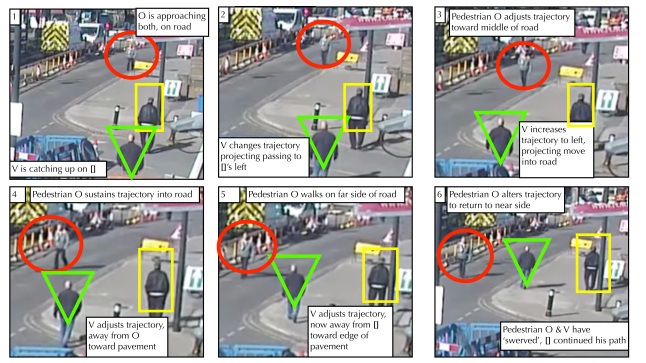Lockdown has been socially, professionally and personally challenging for lots if us; but it has also stimulated a great deal of new work in response to the very different landscape we currently live in. I’m delighted to host a guest blog by four wonderful analysts, Eric Laurier, Magnus Hamann, Saul Albert & Liz Stokoe, who’ve used some of their time for a fascinating analysis of just what “social distancing” means in public spaces. It’s a longer than usual blog, but there’s a lot to pack in…

Walking in the time of COVID 19: On walking and ‘social distancing’ in public space
This blogpost reflects on how the new concept of ‘social distancing’ is produced in public spaces. It started with a sometimes light-hearted, sometimes more serious discussion about this topic on #EMCA twitter, excerpts of which are included in the text below.
Walkers, runners, cyclists, wheelchair users, skateboarders – however we move through the streets, we are noticing who gets out of the way and who gets in our way. We make sense of the new pandemic mobilities’ strangeness and their difficulties as ‘a dance’, ‘a challenge’, ‘a breaching experiment’, ‘a new normal’ etc. As a members’ competence in practical civil society and its politics, moving past one another on the streets, paths and aisles is both more difficult and more morally charged. It is measured and judged in relation to how ‘close’ individuals ought to be to one another.
How do people gauge “distance”? In reflecting on how we measure speed, Harvey Sacks was concerned with differences between the ‘vague’ measurements used by vehicle drivers and the ‘real’ measurements used by scientific researchers. For safe distancing, during this pandemic, this translates into, for example, ‘close’ versus ‘1.5 metres’.
If it is the case that there are alternative measuring systems available at any time when some new phenomenon is introduced into a culture, which the culture is measuring, then what is it that serves to control the selection of some measuring device from among the alternatives? And then, relatedly, what are the features we ought to use to compare measurement devices? Sacks, 1966, Lecture 24, ‘Measurement Systems’
COVID-19 has changed and added to the existing practices, rules, norms and resources for how to conduct oneself as a competent member of a shared social space. Walking in public, amongst a public and as a member of the public, as a recognizable practice now follows a different set of social rules. The utterly familiar practice of walking in public has been transformed by an orientation to this new requirement: ‘social distancing’.
Social distancing is enacted and displayed through embodied practices. One such practice that Liz Stokoe observed in our initial Twitter thread, was the mutual or unilateral ‘swerve’. A feature of the swerve is that it is recognizable as doing something more than just navigating social space. The swerve is recognizable as putting that extra work into creating a safe distance between two or more members/units of the public.
One of the problems for working out how to do safe distancing, via a swerve or other manoeuvre, while on foot, is that the existing transport infrastructure was not built for it. It does not provide resources to draw upon to produce, maintain and easily see 2m gaps. It was built around assumptions of being able to walk or jog or cycle or drive ‘close’ by, stand or pass. An acceptable ‘close’ passing or proximity that, depending on the situation (e.g. squeezing past in the supermarket, crossing a busy road), ran from 2cm to 200cm gaps.
Anyone else noticing this from morning runs? 1) Clocking other runners/walkers from a distance, followed by collaborative social-distancing mutual swerve and a “hello” 😀 versus 2) Being the sole swerver for the seemingly oblivious 😳 #DailyEMCA #EMCA #FlattenTheCurve pic.twitter.com/IV62ppOH7X
— Elizabeth 🧍🏾♀️+ +🧍♀️+ +🧍🏻♀️ Stokoe (@LizStokoe) March 29, 2020
The swerve has rapidly evolved as part of the new Coronavirus idiom. It has projectable qualities that allow us to see it coming, and to see where it will happen in relation to the upcoming spatial features ahead. While some people don’t do mutual swerves even when there is plenty of space to achieve it, people orient to mutuality even when one party can move more readily than another. Through the subtle shift of the body, head, and gaze, both parties can show that they are doing their bit to produce the swerve.
Swerve 12: 0:20-0:30
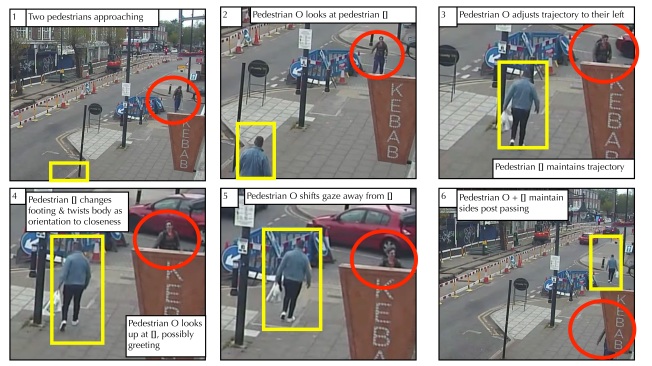 Our first case shows two pedestrians O and [] walking towards each other. It seems that Pedestrian O changes direction to produce a safe distance. In what seems to be a recognition of the restricted path caused by the roadwork ahead (panel 3), Pedestrian [] twist their body as they passes Pedestrian O. Seemingly, they do there in fact show an orientation to swerving, even though there is no free space for them to properly swerve into. As a clear next-turn proof for this interpretation is not available in the data, we rely on our member analysis of how the torque could be interpreted. Just as Pedestrian O does not know the reason for Pedestrian []’s torque, neither do we. But in the same way that we could see Pedestrian []’s torque as an recognition of being close and ‘doing swerving’, we must trust that as a member of the same society so could Pedestrian O. In short, they both seem to acknowledge the closeness. The spacing and the timing of swerving are critical, and we shall see the difference that they make in the following cases in this blog. You can see the video clip here.
Our first case shows two pedestrians O and [] walking towards each other. It seems that Pedestrian O changes direction to produce a safe distance. In what seems to be a recognition of the restricted path caused by the roadwork ahead (panel 3), Pedestrian [] twist their body as they passes Pedestrian O. Seemingly, they do there in fact show an orientation to swerving, even though there is no free space for them to properly swerve into. As a clear next-turn proof for this interpretation is not available in the data, we rely on our member analysis of how the torque could be interpreted. Just as Pedestrian O does not know the reason for Pedestrian []’s torque, neither do we. But in the same way that we could see Pedestrian []’s torque as an recognition of being close and ‘doing swerving’, we must trust that as a member of the same society so could Pedestrian O. In short, they both seem to acknowledge the closeness. The spacing and the timing of swerving are critical, and we shall see the difference that they make in the following cases in this blog. You can see the video clip here.
🗨️Compound TCUs in the time of #coronavirus💬
As me and the dogwalkers mutually (😊) navigate a narrow gap on a footpath running across two open fields:
01 Me: £It’s funny how we all get to th-£=
02 Dogwalker 1: =£the thin bit together£ #EMCA #Swerve #DailyEthno pic.twitter.com/1sTr0q1EmO— Elizabeth 🧍🏾♀️+ +🧍♀️+ +🧍🏻♀️ Stokoe (@LizStokoe) April 22, 2020
A few short weeks after the start of ‘lockdown’, we find that people collaborate not only to produce the appropriate amount of physical social distance, but are already co-producing the account that goes along with it (see tweet at right). We can prepare an account for meeting in an awkward spot that otherwise could be seen, or latterly complained of, as ‘too close’. Explicitly acknowledging such situations pre-empts the moral implications associated with these newly established norms and expectations.
As we noted at the outset, walking in public is a practice of civil society. Walking is one of our local ways of monitoring and appreciating ‘the public’s response to COVID-19’. How many and what types of people are orienting (or not) to safe distancing, are wearing masks, appear stressed/ ill, and so on? Walking on the pavement, as a prime way of appearing as a public character, has always been inferentially rich. ‘You’re hogging the pavement’, ‘I was snubbed’, ‘Well he’s full of himself’, ‘Are they dating?’ and, of course, ‘too close’. Where the latter now takes its pertinence for what kind of character is too close and what kind of character swerves.
Members’ categories. Existing research on mobility and its mutual organisation has established that members of the public produce and recognise and make further use of members’ categories: what is ‘too close’, what category of mobile unit is approaching; with what rights to progress, to maintain its course, to maintain its side-by-side arrangement (Broth & Mondada 2013; Lee & Watson 1993, McIlvenny 2019; Smith 2017; Sudnow 1972). Walking amongst ourselves also, then, presents self and others as occupants, and representative of, mobility categories: walkers, runners, cyclists, skaters, car drivers, van-drivers, yet also by attribution of gender, age, race. These social categories now are re-examined for inferences about responses to the pandemic, one of which is examining whether they are ‘too close’.
How close is ‘close enough’ in a public space?
With each step they take in the course of public walking, members of the walking public project the next steps they are going to take along their current trajectory. When someone deviates from their current course towards another, other walkers ought to constitute ‘close enough’ by responding accordingly.
Swerve 29, 0:05-0:23
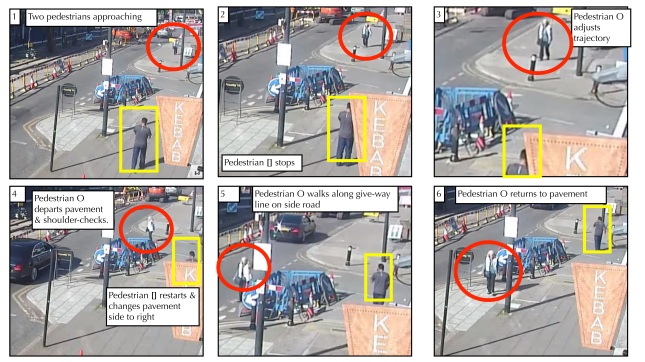 This case shows a rather spectacular case of swerving that would seem quite bizarre only a few weeks ago. One pedestrian (O) navigates a pavement where a mutual swerve comes to appear unlikely. Pedestrian [], on their phone, slows to a stop in the middle of the pavement. At a fairly remote distance O (panel 3) starts the trajectory for their swerve. They have seen that the roadworks will produce a pinch point. They have also anticipated that the other pedestrian might be encountered at this pinch point. Meantime, Pedestrian [], apparently engaged in a phone call, has failed to show that they have seen O and, relatedly, has not moved towards the right hand side of the pavement to open up a ‘safe distance’. In what has become one of the new norms for road sharing, PedestrianO walks along the side of the road to produce their large swerve. You can see the video clip here.
This case shows a rather spectacular case of swerving that would seem quite bizarre only a few weeks ago. One pedestrian (O) navigates a pavement where a mutual swerve comes to appear unlikely. Pedestrian [], on their phone, slows to a stop in the middle of the pavement. At a fairly remote distance O (panel 3) starts the trajectory for their swerve. They have seen that the roadworks will produce a pinch point. They have also anticipated that the other pedestrian might be encountered at this pinch point. Meantime, Pedestrian [], apparently engaged in a phone call, has failed to show that they have seen O and, relatedly, has not moved towards the right hand side of the pavement to open up a ‘safe distance’. In what has become one of the new norms for road sharing, PedestrianO walks along the side of the road to produce their large swerve. You can see the video clip here.
Walking with social distancing measures, alters and makes vague, in its details, the measurements of ‘close’, the judgements of safe distances, of how passing-by ought to be done, of whether rights were exercised or sacrificed (for a similar problem in relation to the arrival of e-Scooters in Paris see Tuncer et al. 2020).
Swerve 1, 0:26-0.39
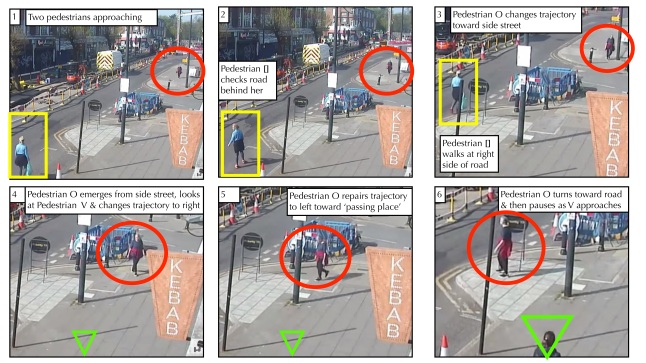 Here we see two pedestrians that anticipate meeting at the same pinch-point. On this occasion pedestrian []moves in to share the road (panel 3). Pedestrian O produces a mutual swerve by also altering her trajectory away from the road. Things get complicated as O exits the pinch point (panel 4) and sees a third pedestrian – V – approaching. It would appear that O’s first move to swerve turns out to be in the same direction as Pedestrian V (panel 4). She then produces a trajectory repair (panel 5), setting up a complimentary mutual swerve. Moreover,Pedestrian O analyses the shape of the pavement, finding an ad hoc passing place at the corner (panel 6). They then pause there while the other pedestrian passes. You can see the video clip here.
Here we see two pedestrians that anticipate meeting at the same pinch-point. On this occasion pedestrian []moves in to share the road (panel 3). Pedestrian O produces a mutual swerve by also altering her trajectory away from the road. Things get complicated as O exits the pinch point (panel 4) and sees a third pedestrian – V – approaching. It would appear that O’s first move to swerve turns out to be in the same direction as Pedestrian V (panel 4). She then produces a trajectory repair (panel 5), setting up a complimentary mutual swerve. Moreover,Pedestrian O analyses the shape of the pavement, finding an ad hoc passing place at the corner (panel 6). They then pause there while the other pedestrian passes. You can see the video clip here.
On each occasion, and in each setting, it is the members’ local accomplishment to show the other that their swerve is initiating and to coordinate it with the other party. The swerve’s success turns on a local analysis, of the ill-suited transport infrastructure, to find features that might help establish either party’s trajectories, speed, gaze etc. It is difficult. Because it is a ‘swerve’ it does not work like, and may never work like, vehicles on the laned road system overtaking one another (Deppermann et al. 2018). As we have seen, one way people are creating the additional space required for a social swerve is for pedestrians to borrow the vehicles’ road space to allow for safe swerving.
Swerve 28, 0:31-0:51
In this case, we have three pedestrians, V and [] travelling in the same direction and O approaching from the opposite direction. Pedestrian V, who is seeking to overtake pedestrian [], finds the opportunity to do this when they leave the pinch point and enter the new pavement (panel 2). We see the first negotiation of trajectories between V and O, when V has an initial trajectory (panel 3) that projects towards the far side of the road. However, V’s trajectory is responsive to 0 adjusting their trajectory to project toward the same far side of the road. V shifts to stay at the edge of the pavement. The overtaking manoeuvre is also going to align all of the pedestrians and so V and O adjust their trajectories to avoid being too close. We see the further fine-tuning involved when Pedestrian [] is having to adjust their trajectory because of an obstacle on the pavement (panels 5 & 6). You can see the video clip here.
In producing safe distancing, there are not just problems with coordinating actions, but also the recognisability of actions. We are not yet familiar enough to see what’s happening on the street ‘at a glance’: are they overtaking, are they crossing the road, are two parties paused, or stopped, or are they just one party, are they paused for me, for someone else, for themselves?
Safe distancing is further complicated by the encounter of one form of mobility with another. Runners move faster than and differently from walkers (Allen-Collinson & Hockey 2015). One radical difference from pedestrians is that they try and avoid ‘stopping’. They tend not to move rapidly sideways. As ‘faster’, runners regularly overtake pedestrians and so are drawn into the swerve-overtake complexities noted above. Pedestrians are regular obstacles for them. Their speed alters how the notion of ‘close’ is measured by pedestrians. A steep swerve in a pedestrian’s movement might index whether the runner has remained noticeably close or not. Runners step and breath louder, and they breathe communicatively (Pehkonen 2020). Their breathing as loud, in its particulars of panting and swallowing, is made sharply relevant by the infectivity of COVID. Meantime, they attract the attention of dogs with a chase instinct. Dogs are, we can note, outside of a routine trouble for runners, an additional complication for social distancing.
Continuing my unscientific study of swerving: this morning, more on unleashed dogs 🏃🏻♀️🐕🐾🐕🐾🐕 Today’s dog was called “Lily. LILY. LILY!!! DON’T WORRY SHE’S FRIENDLY. LILYCOMEHERE” – which reminded me of Fenton #CovidLife #EMCA https://t.co/XagI9ioCGL
— Elizabeth 🧍🏾♀️+ +🧍♀️+ +🧍🏻♀️ Stokoe (@LizStokoe) April 20, 2020
Liz is a runner. Liz’s post began with the noticing of ‘good’ and ‘bad’ passings. Her complaint was lodged in her swerving as a sacrifice of a direct route, all the greater given the runner is the faster party with all the more obstacles. As a sacrifice of rights, it makes an acknowledgement relevant and its absence becomes not just noticeable, but accountable. Yet her swerve, as with other swerves, or ‘stops’, or ‘steps to the side’ is also potentially an offer. The other party can take it. They need not also swerve.
The case here is still relatively simple in dense urban environment yet hints at the complexities to come as lockdown is loosened and we try and re-enter a more crowded public space with its pedestrians, runners, vehicles, visually impaired walkers etc.
Swerve 2, 0:08-0:20
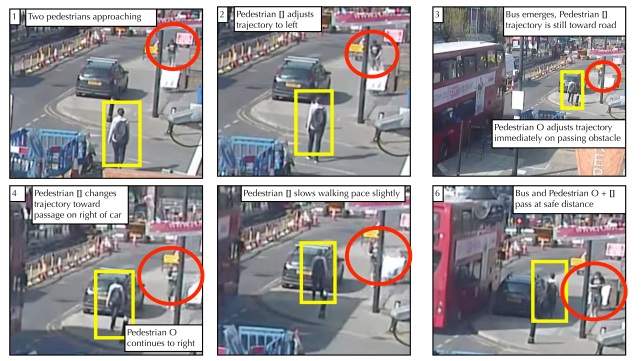
A second pinch point has been produced on the pavement by a car parking on the pavement beyond the roadworks. In the emerging traffic situation Pedestrian [] will go around the car to produce a safe distance and not be too close. However, from behind and approaching relatively quickly is a London double decker bus. Pedestrian [] now has their route blocked by the arrival of the bus at the same time that they would like to share the road. The solution becomes that Pedestrian [] pauses behind the car allowing Pedestrian O to pass through the pinch point. Meantime, Pedestrian O does take a side that produces an orientation to not being too close, even as they are visibly involved in lighting a cigarette while walking. You can see the video clip here.
Alongside understanding how different forms of mobility accomplish and judge how close is too close, who should swerve and so on, there is also the rich array of relevant categories we touched on earlier. We recognise members of the public moving through the transport system in terms of their age, their health, as pushers of baby-buggies, wheelchair users etc. As we might hold the doors for certain others, we might be the ones to go out of our way. Yet as we have hinted at earlier, we have to fit that practice to analysing the local environment of walls, ditches and banks. Moreover, we have to shape our swerve by make sense of and judging the other’s line of movement.
References
Allen-Collinson, J., & Hockey, J. (2015). From a Certain Point of View: Sensory Phenomenological Envisionings of Running Space and Place. Journal of Contemporary Ethnography, 44(1), 63–83. https://doi.org/10.1177/0891241613505866
Broth, M., & Mondada, L. (2013). Walking away: The embodied achievement of activity closings in mobile interaction. Journal of Pragmatics, 47(1), 41–58. https://doi.org/10.1016/j.pragma.2012.11.016
Deppermann, A., Laurier, E., Mondada, L., Broth, M., Cromdal, J., De Stefani, E., … Rauniomaa, M. (2018). Overtaking as an interactional accomplishment. Gesprachsforschung – Online-Zeitschrift Zur Verbalen Interaktion, 19, 1–131. http://www.gespraechsforschung-online.de/2018.html
Lee, J. R. E., & Watson, R. (1993). Interaction in public space: Final Report to the Plan Urbain. Paris: Plan Urbain.
McIlvenny, P. (2019). How did the mobility scooter cross the road? Coordinating with co-movers and other movers in traffic. Language and Communication, 65, 105–130. https://doi.org/10.1016/j.langcom.2018.04.002
Pehkonen, S. (2020). Response Cries Inviting an Alignment: Finnish huh huh. Research on Language and Social Interaction, 53(1), 19–41. https://doi.org/10.1080/08351813.2020.1712965
Sacks, H. (1992) Lectures on Conversation. Oxford: Blackwell
Smith, R. J. (2017). Membership categorisation, category-relevant spaces, and perception-in-action: The case of disputes between cyclists and drivers. Journal of Pragmatics, 118, 120–133. https://doi.org/10.1016/j.pragma.2017.05.007
Sudnow, D. (1972). Temporal Parameters of Interpersonal Observation Studies in Social Interaction. In D. Sudnow (Ed.) (pp. 260–282). London: The Free Press.
Tuncer, S., Laurier, Eric, Licoppe, C., & Brown, B. (2020). Notes on the practices and appearances of e-scooters in public space. Journal of Transport Geography, In press, https://www.ericlaurier.co.uk/resources/Writings/Tuncer_2020_e-scooters.pdf.

